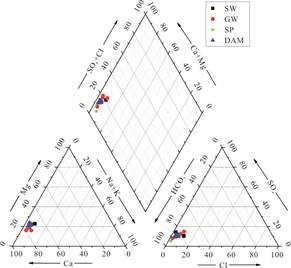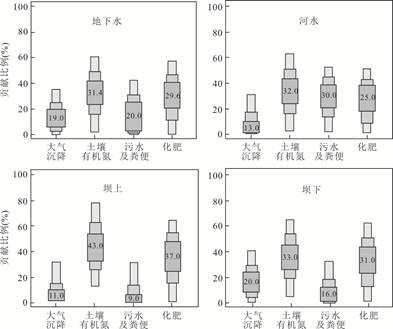Hydrochemical Characteristics and Tracing of Nitrate Sources in Quanshui River Catchment, Hubei Province
-
摘要: 目前针对喀斯特山区及平原过渡带天然河流硝酸盐的来源识别与追踪的研究鲜有报道,也较少考虑湿润气候区反季节性干旱气候特征对硝酸盐迁移规律的影响.以汉江二级支流泉水河流域为例,分析了从源头喀斯特地区、中间过渡区、平原区地表水和地下水硝酸盐含量及组成的空间变化,采用氮氧同位素识别地表水和地下水硝酸盐来源,利用SIAR模型定量计算各污染源的贡献率.结果表明:土壤有机氮、污水粪便、化肥和大气沉降对地下水硝酸盐来源贡献占比分别为31.4%、20.0%、29.6%和19.0%,对地表水硝酸盐来源的比例分别为32.0%、30.0%、25.0%和13.0%,污水粪便对地表水硝酸盐贡献比例较地下水增高;坝上水样因水体较大,自净能力较强,受污水粪便的影响很小(仅为9.0%),坝上水样硝酸盐土壤有机氮、大气沉降和化肥的贡献占比分别为43.0%、11.0%和37.0%.枯水期河水主要由地下水缓慢补给,无地表径流汇入,土壤有机氮为河流主要的硝酸盐来源,河流中下游更易受人类活动影响,生活污水和化肥对河流硝酸盐贡献增大.Abstract: There are few studies on the source identification of nitrate in the natural rivers in karst area, and even fewer on the influence of the anti-seasonal arid climate on the nitrate transportation. In this paper, δ15N and δ18O isotopic tracing method is used to analyze the source of nitrate in surface water and groundwater of Quanshui River, a branch of Hangjiang River and to determine the biological and chemical transformation process of nitrate. The contribution rate of each pollution terminal element was determined quantitatively by using the model of Stable Isotope Analysis in R (SIAR). The results show that soil organic nitrogen, sewage manure, fertilizer and atmospheric subsidence contributed 31.4%, 20.0%, 29.6% and 19.0% respectively to the nitrate source of groundwater, and the proportion of nitrate source to surface water was 32.0%, 30.0%, 25.0% and 13.0%. The contribution of sewage manure to surface water nitrate is significantly higher than that of groundwater. Due to the large water body, the water in the reservoir has strong self-purification ability and is almost unaffected by sewage manure (only 9.0%).The contribution of soil organic nitrogen, atmospheric subsidence and fertilizer in the nitrate soil of the reservoir was 43.0%, 11.0% and 37.0%, respectively. In dry season, groundwater is mainly recharged slowly by groundwater. Because groundwater is affected by soil in vadose zone, soil organic nitrogen is the main source of nitrate in the river. The downstream of the river is more susceptible to human activities, and the contribution of domestic sewage and chemical fertilizer to nitrate in rivers increases.
-
Key words:
- nitrate pollution /
- nitrogen and oxygen isotopes /
- source identification /
- SIAR model /
- Quanshui River /
- hydrogeology
-
表 1 泉水河流域水体物理和化学指标及硝酸盐氮氧同位素组成
Table 1. Physical and chemical parameters and nitrate nitrogen and oxygen isotope composition of groundwater and surface water in Quanshui River catchment
样点 温度
(℃)EC
(μs/cm)DO
(mg/L)pH N-NH 4 +
(mg/L)N-NO 3 −
(mg/L)N-NO 2 −
(ug/L)δ15N-NO 3 −
(‰)δ18O-NO 3 −
(‰)Ca2+
(mg/L)HCO 3 −
(mg/L)Mg2+
(mg/L)Cl−
(mg/L)SO 4 2−
(mg/L)K+
(mg/L)Si+
(mg/L)Na
(mg/L)SW1 25.7 496 3.84 7.79 0.410 0.10 7 -5.18 20.16 86 280.6 21.77 6.96 48.10 2.45 4.08 3.72 GW1 21.1 993 2.06 7.08 0.410 14.11 19 7.42 15.54 149 469.7 44.52 66.29 60.55 1.54 4.25 6.21 SW2 25.2 750 6.58 7.57 0.376 2.20 9 8.24 4.85 116 420.9 36.74 22.76 60.52 1.24 4.60 4.45 GW2 19.0 779 2.32 7.31 0.239 7.06 26 15.51 -5.76 136 463.6 27.42 11.89 42.42 1.66 5.19 5.34 SW3 25.5 623 4.92 7.58 0.205 2.40 2 -1.64 23.30 96 335.5 29.35 26.86 41.34 1.62 3.97 6.05 GW3 18.8 752 1.74 7.18 0.222 10.33 47 3.42 9.92 126 372.1 30.27 34.65 59.19 1.38 4.60 5.73 SW4 29.8 585 9.39 7.54 0.462 3.20 3 -0.19 13.73 82 274.5 27.17 38.30 37.15 1.35 5.10 8.79 GW4 18.7 574 3.03 6.66 0.313 9.76 6 -5.49 22.61 98 262.3 20.77 31.17 51.33 0.90 10.36 10.59 SP 21.9 572 3.41 7.83 0.125 1.34 2 7.07 1.87 96 378.2 25.45 9.08 21.51 1.29 5.64 6.29 DAM1a 29.7 811 8.15 7.91 0.313 0.46 7 3.18 15.91 100 384.3 31.81 15.81 40.84 1.00 3.66 3.16 DAM1b 27.4 619 9.07 7.98 0.085 0.88 7 -0.24 8.90 96 347.7 31.60 14.25 44.38 1.08 3.81 3.41 DAM2a 26.7 662 8.95 7.85 0.085 2.03 22 4.42 2.77 112 372.1 32.76 20.62 42.65 1.54 3.99 4.48 DAM2b 27.1 811 8.38 7.81 0.382 1.72 15 -0.37 9.98 120 384.3 32.42 21.23 46.00 1.66 4.16 4.27 DAM3a 28.5 862 6.82 7.74 0.114 0.00 2 -1.13 26.56 106 353.8 29.79 23.47 50.24 1.48 5.13 5.23 DAM3b 26.8 764 7.88 7.78 0.245 0.29 6 2.27 10.31 99 341.6 27.66 18.70 40.52 1.49 5.26 4.81 DAM4a 27.8 747 7.72 7.97 0.194 0.21 9 1.76 17.48 98 341.6 26.98 23.97 42.40 1.68 4.54 4.98 DAM4b 26.1 589 7.93 7.73 0.228 0.50 7 3.08 20.15 88 323.3 26.22 23.95 41.80 1.57 4.61 5.27 表 2 泉水河源头至下游地表水和地下水硝态氮、氨氮浓度变化
Table 2. Changes in nitrate nitrogen and ammonia nitrogen concentration of surface water and groundwater from the source to the downstream of the Quanshui River catchment
样点 N-NO3-
(mg/L)N-NH4+
(mg/L)N-NO2-
(ug/L)SW1 0.10 0.410 7 SW2 2.20 0.376 9 SW3 2.40 0.205 2 SW4 3.20 0.462 3 SP 1.34 0.125 2 GW1 14.11 0.410 19 GW2 7.06 0.239 26 GW3 10.33 0.222 47 GW4 9.76 0.313 6 DAM1a 0.46 0.313 7 DAM1b 0.88 0.085 7 DAM2a 2.03 0.085 22 DAM2b 1.72 0.382 15 DAM3a 0.00 0.114 2 DAM3b 0.29 0.245 6 DAM4a 0.21 0.194 9 DAM4b 0.50 0.228 7 -
Bayram A., Ö nsoy H.İ., Kö mürcü M., et al. 2012. Effects of Torul Dam on Water Quality in the Stream Harşit, NE Turkey. Environmental Earth Sciences, 65(3): 713-723. https://doi.org/10.1007/s12665-011-1118-5 doi: 10.1007/s12665-011-1118-5 Dong H.Y., Wang W.D., Qiang Z.M., et al.2014.In-Situ Remediation of Polluted Hilly River with Permeable Dams. Chinese Journal of Environmental Engineering, 8(10):4249-4253 (in Chinese with English abstract). http://d.old.wanfangdata.com.cn/Periodical/hjwrzljsysb201410033 Elizabeth W. B., Christine L. G., Norbert A. J., et al. 2002. Anthropogenic Nitrogen Sources and Relationships to Riverine Nitrogen Export in the Northeastern U.S.A.. Biogeochemistry, 57(1): 137-169. https://doi.org/10.1023/a:1015709302073 http://cn.bing.com/academic/profile?id=1f84583cad4b439dca9f91c887cc60e5&encoded=0&v=paper_preview&mkt=zh-cn Feng J.X., Zhu J.J., Chen L., et al. 2006. Nitrate Contamination of Groundwater and Its Control and Evaluation Forecast Methods. Ground Water, 28(4):58-62 (in Chinese with English abstract). http://www.wanfangdata.com.cn/details/detail.do?_type=perio&id=dixs200604022 Gibbs R. J.. 1970. Mechanisms Controlling World Water Chemistry. Science, 170(3962): 1088-1090. https://doi.org/10.1126/science.170.3962.1088 http://d.old.wanfangdata.com.cn/NSTLQK/NSTL_QKJJ0232095384/ Heaton T. H. E.. 1986. Isotopic Studies of Nitrogen Pollution in the Hydrosphere and Atmosphere: A Review. Chemical Geology: Isotope Geoscience Section, 59(2): 87-102. https://doi.org/10.1016/0168-9622(86)90059-x doi: 10.1016-0009-2541(86)90046-X/ Huang W. C.. 2010. Study on Structural Deformation Characteristics of Xiangfan-Guangji Fault Zone (Dissertation). Hefei University of Technology, Hefei (in Chinese with English abstract). Kendall C.. 1998. Tracing Nitrogen Sources and Cycling in Catchments. In: Kendall C., McDonnell J.J., eds., Isotope Tracers in Catchment Hydrology. Elsevier, Oxford. https://doi.org/10.1016/b978-0-444-81546-0.50023-9 Kendall C., Elliott E. M., Wankel S. D.. 2007. Tracing Anthropogenic Inputs of Nitrogen to Ecosystems. In: Michener R. H., Lajtha K., eds., Stable Isotopes in Ecology and Environmental Science. Blackwell Scientific Publication, Oxford. https://doi.org/10.1002/9780470691854.ch12 Li G., Han Z. W., Shen C. H., et al. 2019. Distribution Characteristics and Causes of Nitrate in Waters of Typical Small Karst Catchment: A Case of the Houzhai River Catchment. Earth Science, 44(9):2899-2908 (in Chinese with English abstract). http://en.cnki.com.cn/Article_en/CJFDTOTAL-DQKX201705017.htm Li S. L., Liu C. Q., Xiao H. Y., et al. 2005. Using δ15N to Assess Groundwater Nitrogen Pollution in Guiyang. Geochimica, 34(3):257-262 (in Chinese with English abstract). http://www.cnki.com.cn/Article/CJFDTotal-DQHX200503006.htm Liu C. Q., Li S. L., Lang Y. C., et al. 2006. Using δ15N and δ18O Values to Identify Nitrate Sources in Karst Ground Water, Guiyang, Southwest China. Environmental Science & Technology, 40(22): 6928-6933. https://doi.org/10.1021/es0610129 http://www.cnki.com.cn/Article/CJFDTotal-DQHB2006S1350.htm Liu T., Wang F., Michalski G., et al. 2013. Using δ15N, δ17O, and δ18O to Determine Nitrate Sources in the Yellow River, China. Environmental Science & Technology, 47(23): 13412-13421. https://doi.org/10.1021/es403357m http://www.wanfangdata.com.cn/details/detail.do?_type=perio&id=0507ae7f85964ff80bef85e44ef5ab0d Michener R. H., Lajtha K.. 2007. Stable Isotopes in Ecology and Environmental Science. Blackwell Scientific Publication, Oxford. Otero N., Soler A., Canals, À .. 2004. Fertilizer Characterization: Isotopic Data (N, S, O, C, and Sr). Environmental Science & Technology, 38(12): 3254-3262. https://doi.org/10.1021/es0348187 http://d.old.wanfangdata.com.cn/NSTLQK/NSTL_QKJJ0215108971/ Parnell A. C., Inger R., Bearhop S., et al. 2010. Source Partitioning Using Stable Isotopes: Coping with too Much Variation. PlOS ONE, 5(3): e9672. https://doi.org/10.1371/journal.pone.0009672 http://d.old.wanfangdata.com.cn/OAPaper/oai_pubmedcentral.nih.gov_2837382 Petitta M., Fracchiolla D., Aravena R., et al. 2009. Application of Isotopic and Geochemical Tools for the Evaluation of Nitrogen Cycling in an Agricultural Basin, the Fucino Plain, Central Italy. Journal of Hydrology, 372(1-4): 124-135. https://doi.org/10.1016/j.jhydrol.2009.04.009 http://www.wanfangdata.com.cn/details/detail.do?_type=perio&id=812907603844cb39245ed895b1514597 Ping X., Xian Y., Jin M. G., et al. 2018. Influence of Bioclogging on Nitrogen Cycling in a Hyporheic Zone with an Undulate River-Bed. Earth Science, 43(S1):171-180 (in Chinese with English abstract). http://www.wanfangdata.com.cn/details/detail.do?_type=perio&id=dqkx2018z1017 Shen S., Ma T., Du Y., et al. 2017. Dynamic Variations of Nitrogen in Groundwater under Influence of Seasonal Hydrological Condition in Typical Area of Jianghan Plain. Earth Science, 42(5):674-684 (in Chinese with English abstract). http://www.wanfangdata.com.cn/details/detail.do?_type=perio&id=dqkx201705003 Su C. L., Zhang Y., Ma Y. H., et al. 2019. Hydrochemical Evolution Processes of Karst Groundwater in Guiyang City: Evidences from Hydrochemistry and 87Sr/86Sr Ratios. Earth Science, 44(9): 2829-2838 (in Chinese with English abstract). Viswanathan V.C., Jiang Y. J., Berg M., et al. 2016. An Integrated Spatial Snap-Shot Monitoring Method for Identifying Seasonal Changes and Spatial Changes in Surface Water Quality. Journal of Hydrology, 539: 567-576. doi: 10.1016/j.jhydrol.2016.05.017 Vuorenmaa J., Rekolainen S., Lepistö A., et al. 2002. Losses of Nitrogen and Phosphorus from Agricultural and Forest Areas in Finland during the 1980s and 1990s. Environmental Monitoring and Assessment, 76(2):213-248. https://doi.org/10.1023/a:1015584014417 http://www.wanfangdata.com.cn/details/detail.do?_type=perio&id=504e34c5cd84e67871f9e0d379e92bd0 Williard K. W. J., DeWalle D. R., Edwards P. J., et al. 2001. 18O Isotopic Separation of Stream Nitrate Sources in Mid-Appalachian Forested Watersheds. Journal of Hydrology, 252(1-4): 174-188. https://doi.org/10.1016/s0022-1694(01)00459-0 http://www.wanfangdata.com.cn/details/detail.do?_type=perio&id=58a9f4f603757aa0a6ec65272347a86e Wu W. H., He X. J., Su Y. L., et al. 2016. Review on Identifying Nitrogen Pollution Sources in Water Based on the Nitrogen and Oxygen Stable Isotope. Environmental Science & Technology, 39(8):77-84 (in Chinese with English abstract). https://www.sciencedirect.com/science/article/pii/S0269749117307194 Xiao H.Y., Liu C.Q.. 2004.Nitrogen Isotope Studies on Seasonal Nitrogen Pollution of Inflowing Rivers of Hongfeng Lake, Guizhou Province.Geology-Geochemistry, 32(1):71-75 (in Chinese with English abstract). http://www.wanfangdata.com.cn/details/detail.do?_type=perio&id=dzdqhx200401012 Xing M., Liu W. G.. 2016. Nitrate Source Proportional Contributions in the Chanhe and Bahe Rivers—Using Its Isotopic Ratios in Combination with a Bayesian Isotope Mixing Mode. Journal of Earth Environment, 7(1):27-36 (in Chinese with English abstract). Xue D. M., de Baets B., van Cleemput O., et al. 2012. Use of a Bayesian Isotope Mixing Model to Estimate Proportional Contributions of Multiple Nitrate Sources in Surface Water. Environmental Pollution, 161(1): 43-49. https://doi.org/10.1016/j.envpol.2011.09.033 http://www.wanfangdata.com.cn/details/detail.do?_type=perio&id=e832cae0bd2cf38643f0fc09505d8fbd Yu H. T., Ma T., Deng Y. M., et al. 2017. Hydrochemical Characteristics of Shallow Groundwater in Eastern Jianghan Plain. Earth Science, 42(5):685-692 (in Chinese with English abstract). http://www.wanfangdata.com.cn/details/detail.do?_type=perio&id=dqkx201705004 Yue F. J., Liu C. Q., Li S. L., et al. 2014. Analysis of δ15N and δ18O to Identify Nitrate Sources and Transformations in Songhua River, Northeast China. Journal of Hydrology, 519: 329-339. https://doi.org/10.1016/j.jhydrol.2014.07.026 Zhang Y. P., Niu J. Q., Wang W., et al. 2010. Geochemical Characteristics and Heat Source of the Geothermal Field in Jingshan Area, Hubei Province. Geophysical and Geochemical Exploration, 34(6):806-809, 813 (in Chinese with English abstract). http://www.wanfangdata.com.cn/details/detail.do?_type=perio&id=wtyht201006024 董慧峪, 王为东, 强志民, 等. 2014.透水坝原位净化山溪性污染河流.环境工程学报, 8(10):4249-4253. http://d.old.wanfangdata.com.cn/Periodical/hjwrzljsysb201410033 冯锦霞, 朱建军, 陈立, 等. 2006.我国地下水硝酸盐污染防治及评估预测方法.地下水, 28(4):58-62. http://d.old.wanfangdata.com.cn/Periodical/dixs200604022 黄文成. 2010.襄樊-广济断裂带的构造变形特征研究.合肥: 合肥工业大学. http://cdmd.cnki.com.cn/Article/CDMD-10359-2010246545.htm 李耕, 韩志伟, 申春华, 等. 2019.典型岩溶小流域水体中硝酸盐分布特征及成因:以普定后寨河流域为例.地球科学, 44(9):2899-2908. doi: 10.3799/dqkx.2019.170 李思亮, 刘丛强, 肖化云, 等. 2005. δ15N在贵阳地下水氮污染来源和转化过程中的辨识应用.地球化学, 34(3):257-262. http://d.old.wanfangdata.com.cn/Periodical/dqhx200503006 平雪, 鲜阳, 靳孟贵, 等. 2018.河床起伏条件下生物堵塞对潜流带氮素迁移转化的影响.地球科学, 43(S1):171-180. http://d.old.wanfangdata.com.cn/Periodical/dqkx2018z1017 沈帅, 马腾, 杜尧, 等, 2017.江汉平原典型地区季节性水文条件影响下氮的动态变化规律.地球科学, 42(5):674-684. doi: 10.3799/dqkx.2017.055 苏春利, 张雅, 马燕华, 等, 2019.贵阳市岩溶地下水水化学演化机制:水化学和锶同位素证据.地球科学, , 44(9): 2829-2838. doi: 10.3799/dqkx.2019.214 吴文欢, 何小娟, 苏跃龙, 等. 2016.基于氮氧稳定同位素识别水体氮源的研究进展.环境科学与技术, 39(8):77-84. http://www.wanfangdata.com.cn/details/detail.do?_type=perio&id=hjkxyjs201608013 肖化云, 刘丛强. 2004.氮同位素示踪贵州红枫湖河流季节性氮污染.地球与环境, 32(1):71-75. http://d.old.wanfangdata.com.cn/Periodical/dzdqhx200401012 邢萌, 刘卫国. 2016.浐河、灞河硝酸盐端元贡献比例——基于硝酸盐氮、氧同位素研究.地球环境学报, 7(1):27-36. http://www.wanfangdata.com.cn/details/detail.do?_type=perio&id=dqhjxb201601004 於昊天, 马腾, 邓娅敏, 等. 2017.江汉平原东部地区浅层地下水水化学特征.地球科学, 42(5):685-692. doi: 10.3799/dqkx.2017.056 张元培, 牛俊强, 王炜, 等. 2010.湖北京山地区地热田地球化学特征及热源分析.物探与化探, 34(6):806-809, 813. http://d.old.wanfangdata.com.cn/Periodical/wtyht201006024 -










 下载:
下载:





